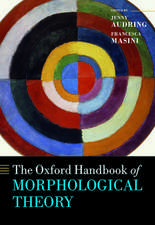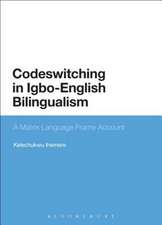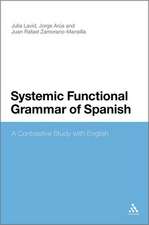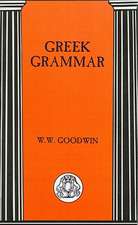An Introduction to Syntax: Fundamentals of Syntactic Analysis
Autor Dr. Edith A. Moravcsiken Limba Engleză Paperback – 3 mai 2006
| Toate formatele și edițiile | Preț | Express |
|---|---|---|
| Paperback (1) | 306.65 lei 6-8 săpt. | |
| Bloomsbury Publishing – 3 mai 2006 | 306.65 lei 6-8 săpt. | |
| Hardback (1) | 1154.81 lei 6-8 săpt. | |
| Bloomsbury Publishing – 3 mai 2006 | 1154.81 lei 6-8 săpt. |
Preț: 306.65 lei
Nou
Puncte Express: 460
Preț estimativ în valută:
58.68€ • 61.39$ • 48.74£
58.68€ • 61.39$ • 48.74£
Carte tipărită la comandă
Livrare economică 03-17 aprilie
Preluare comenzi: 021 569.72.76
Specificații
ISBN-13: 9780826489463
ISBN-10: 082648946X
Pagini: 288
Dimensiuni: 156 x 234 x 21 mm
Greutate: 0.44 kg
Editura: Bloomsbury Publishing
Colecția Continuum
Locul publicării:London, United Kingdom
ISBN-10: 082648946X
Pagini: 288
Dimensiuni: 156 x 234 x 21 mm
Greutate: 0.44 kg
Editura: Bloomsbury Publishing
Colecția Continuum
Locul publicării:London, United Kingdom
Caracteristici
It is also an area that students find difficult - this book aims to make syntax accessible to students.
Cuprins
Preface 1. What is Syntax? 2. Linear Order 3. Selection 4. Categories 5. Syntax, meaning and sound form 6. Variation and change 7. Explaining syntax
Glossary
Glossary
Recenzii
Unlike most syntax textbooks, this one approaches the technicalities via a broad consideration of explanation illustrated from everyday life. The discussion presents the view of a leading scholar in the field, whose enthusiasm, wisdom and open-mindedness show through on every page. It draws from a wide range of languages and culminates in a splendid chapter about the ultimate explanatory force for syntax: function.
This book, which contains a rich coverage of the various syntactic theories and how they accommodate conflicts, presents a substantial contribution to an understanding of the differences as well as the shared goals among these theories. In sum, An introduction to syntactic theory is highly recommended as a valuable resource for anyone learning or teaching syntax.
[The] book is incredibly well organized, obviously the product of a very tidy mind. Each chapter opens with a chart of the numbered content and its pagination, in slightly greater detail than the listing of chapter contents in the introductory material. Then, before the chapter begins, there is an ingenious and intriguing quote that is fundamentally relevant to what is to come ([the] book is worth browsing just to digest these quotes!). Each chapter also ends with a relevant and welcome conclusion, followed by the notes and some exercises for the students when used as a course book.
This book, which contains a rich coverage of the various syntactic theories and how they accommodate conflicts, presents a substantial contribution to an understanding of the differences as well as the shared goals among these theories. In sum, An introduction to syntactic theory is highly recommended as a valuable resource for anyone learning or teaching syntax.
[The] book is incredibly well organized, obviously the product of a very tidy mind. Each chapter opens with a chart of the numbered content and its pagination, in slightly greater detail than the listing of chapter contents in the introductory material. Then, before the chapter begins, there is an ingenious and intriguing quote that is fundamentally relevant to what is to come ([the] book is worth browsing just to digest these quotes!). Each chapter also ends with a relevant and welcome conclusion, followed by the notes and some exercises for the students when used as a course book.

























